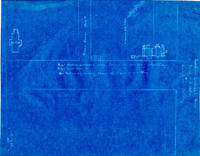Saunders—Dinwiddie House Historical Report, Block 30 Building 13 & 14Originally entitled: "Saunders-Dinwiddie House, Block 30 #13, & #14"
Colonial Williamsburg Foundation Library Research Report Series—1639
Colonial Williamsburg Foundation Library
Williamsburg, Virginia
1994
SAUNDERS—DINWIDDIE HOUSE. Block 30 #13, & #14.
October 23, 1930.
At a very early date a house stood on the site of the present Saunders-Dinwiddie House. Its natural possibilities for garden development made it a desirable location for a Gentleman's residence. This it was from the earliest deeds of which we have record, being tenanted by Dr. Kenneth McKenzie, Robert Carter Nicholas, Gov. Dinwiddie, Hon. Rob't Carter and William Carter at various times in the 18th. century.
On October 7, 1747, Robert Cary of London deeded lots #333-334, 335 & 336 to Dr. Kenneth McKenzie, Doctor of Physic, describing it as the messuage house and lands purchased from Charles Carter. The Doctor lived in this house, which according to the inventory of his estate in 1755, was lavishly furnished with mahogany furniture and contained an extensive library, chiefly of medical books.
John Blair noted in his diary in November 1751 an order to buy the home of Dr. Kenneth McKenzie for the use of Governor Dinwiddie while the Palace was being repaired.
The Receiver General accordingly on December 20, 1751, purchased "The Messuage Houses and 4 lotts situate in Palace Street in Williamsburg" for £537/10/00. The house, and its extensive grounds thus sold for a relatively high figure for the period. The Receiver General deeded the property to Robert Carter Nicholas Attorney-at-Law in December 1753 for £450.
Robert Carter Nicholas lived in the house for the next eight years, selling the "4 lotts and buildings thereon erected, with all ways, etc. to the Honorable Robert Carter" in May 7, 1761 for 2 £650.
Wm. Carter, the surgeon, at this time owned the other two lots from Robert Carter's lot to Prince George Street. During this time a dispute over the boundary between the Carter lots took place which was settled by William Carter deeding Robert the piece in dispute for 5 Shillings and "peace of mind".
Wm. Carter deeded his two lots to James Carter, surgeon, and John Carter, Merchant. This gave the house an entire square along Palace Street in June 1767, which contained the buildings in which Wm. Carter lived. The property was advertised for sale in the Virginia Gazette:
"Oct. 17, 1777—For sale: R.C. Nicholas house and lots in the city of Williamsburg. The square being surrounded by streets is detached from all other buildings and contains about 8 lots, the greater part of which constitutes a large garden, well enclosed, and well cropped. Dwelling house is large and commodious, having four rooms on a floor, and is in pretty good repair. The offices are numerous and convenient some nearly as good as new, a fine spring near the house. Also a large pasture adjoining the City."
The building was still for sale six years later, at which time the following description of the house was given in the Virginia Gazette:
"March 29, 1783—For Sale: The well-known tenement which was formerly occupied by R.C. Nicholas Esq. The house is two stories high, with four rooms on a floor and nine closets, some of them will hold a bed, table and two chairs; also two houses in front, with a garden paled in, stable to hold 15 horses, pasture, etc. Also my brick house adjoining Raleigh Tavern, with a store and counting room below and four rooms above, kitchen, etc. - John Carter."
The Frenchman's Map, although there is an error in the 3 North-South portions, the map still seems to retain the relations between buildings and their outbuildings and their respective sizes. The blue prints with this report show the Frenchman's Map superimposed on the present Saunders-Dinwiddie house and outbuildings.
Elkanah Deane, a coach-maker, owned the lots on the corner of Prince George and Palace Streets and carried on his business there during the last quarter of the 18th century, according to extensive evidence on the Virginia Gazette.
Saunders was the owner of the entire block in the ante-bellum days, according to the following description from Mr. Charles "Recollections of Williamsburg":
".............the 'Saunder's House', with its numerous out houses, such as kitchen, servant's quarters, etc. This house presented then much the same appearance that it does today, with its double front porch supported by white columns built of brick. This was the hospitable home of 'Bob Saunders', once president of the College of William and Mary, and professor of Mathematics. He was for many years mayor of this City. He was widely known and highly esteemed. He owned many slaves and an extensive plantation on York River. He died not long after the War and was buried in the garden of his home under a big weeping willow tree where now can be seen the tombstone that marks his final resting place. Nearly on the site of the Presbyterian Church, there was a big barn and carriage house and to the Westward of it, up to recent years, was a small wooden house, used as the coachman's abode. Mr. Saunders owned the entire square at the northwest corner of which was a 'burying ground' for the colored.
Memorandum
Further research by this department in the Governor Dinwiddie Papers may yield additional data. The Yorktown Wills and Inventories may be expected to give a small amount of additional data.
Submitted by
Harold R. Shurtleff, Director
Department of Research & Records
Report By:
Helen Bullock
